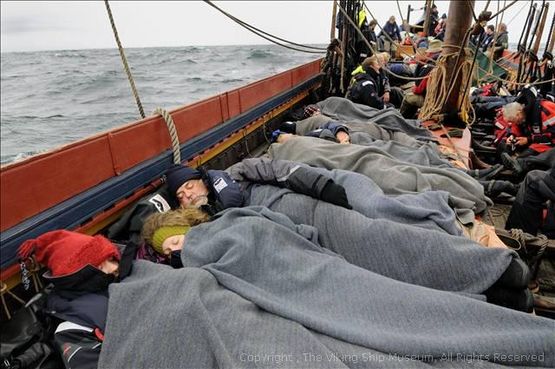The Sea Stallion is on its way northwards along the east coast of England from Ramsgate to Lowestoft. Right now we are entering the Thames estuary and sailing at 9.5 knots with Knock Deep abaft the beam. The sea is moderate, the wind is about 24 knots; it is overcast and about 18°C. Perfect wind and weather for the Sea Stallion and the crew.
And the warmth is doing us good. There have really been a lot of cold and rainy days, so we all have experience with clothing and protection against the weather. And there are many ways of protecting yourself and many views about clothing.
There are two main views: woollens or synthetics. There are only a few at the two extremes and most of us combine woollen and modern clothing.
On the wool side, there are those who wear wool from the outermost to the innermost layer. Underclothes, socks, sweater, trousers, cap, gloves – everything is wool apart from the outermost, watertight layer. The advantage is first and foremost wool’s ability to keep the body warm when we are sitting still for long periods in 8-10 degrees and the wind is blowing around us and without any possibility of creating proper shelter. The greatest disadvantage is that wool takes up a lot of room in the 80 litres of personal baggage, which is the limit on board. A large woollen sweater and a pair of woollen trousers occupy almost half of the available room for a grown man size XXL. If the woollen clothing gets drenched by the sea that sometimes pours into the ship, then you can look forward to one to two days’ drying time; in the meantime, you feel heavy and wet.
On the synthetic side are the people who use 'hi-tech clothing’ – primarily made of polyester and other synthetic materials. The most obvious advantage is that it takes up very little room. Fleece jackets, synthetic underclothes, watertight jackets and trousers – everything can be packed and squashed together to almost nothing. They keep you dry and thus also comparatively warm. The disadvantages are that too many people onboard are not warm enough, and if you get the ultimate shower of water that makes you wet under the many layers of polyester, then it can be impossible to get warm again.
So many of us combine the two types of clothing. Woollen underclothes and socks, sturdy work trousers, soft-shell, thick woollen sweater, woollen cap, large neoprene boots, and many of us have large offshore sailing jackets and trousers that can breathe and are watertight as the outermost layer.
And yet we can still freeze so much our teeth don’t stop chattering.
So on the free watch we creep under woollen blankets and tarpaulins and snuggle up close to one another. We have to put up with some loud snores – but that’s the price for keeping warm.
